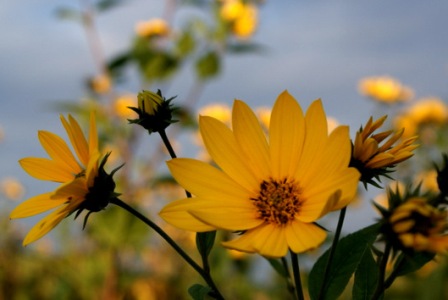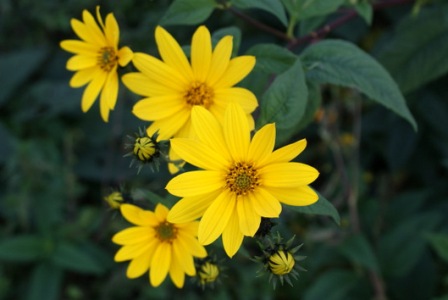7. Helianthus tuberosus L. (syn.: H. tomentosus Michaux) (N-Am.) – A locally naturalised escape from cultivation or garden throw-out. First recorded in a meadow near a granary in Wilsele in 1893 (probably only ephemeral). Known at least since the 1920’s from river Vesdre, at first near Ensival but soon very abundant in large parts of the valley. All records were initially ascribed to the only superficially similar Heliopsis helianthoides. Furthermore recorded along river Lomme (1940) and Dender (1949) but probably not persistent. At present exceedingly abundant along river Maas but its invasion history is rather poorly documented. These populations were probably issued from those along river Vesdre. There are numerous additional records in widely scattered localities (Van Looy 2006) but most are surely in error for Helianthus xlaetiflorus (for instance those along river Schelde). In fact, Helianthus tuberosus is much more rarely cultivated in Belgium (and rather as a minor crop or for pheasant food than as an ornamental). It is chiefly found on riverbanks, more rarely on wasteland. Helianthus tuberosus frequently grows in massive stands and locally is a noxious environmental weed (it also penetrates in agricultural fields in river valleys). Additional information on its invasion history in Belgium is available at: http://ias.biodiversity.be/species/show/60.
Helianthus tuberosus never produces seeds in Belgium and flowers only very late (or not at all). It spreads fast by rhizomes. Outside of cultivation tubers are only rarely produced (or remain very small).
Recent molecular data demonstrated that Helianthus tuberosus arose as a hybrid of H. hirsutus and H. grosseserratus (Bock & al. 2014).
 |
 |
 |
Selected literature:
Adolphi K. (1995) Neophytische Kultur- und Anbaupflanzen als Kulturflüchtlinge des Rheinlandes. Nardus 2: 272 p.
Bock D.G., Kane N.C., Ebert D.P. & Rieseberg L.H. (2014) Genome skimming reveals the origin of the Jerusalem Artichoke tuber crop species: neither from Jerusalem nor an artichoke. New Phytol. 201(3): 1021-1030. [available online at: http://rieseberglab.sites.olt.ubc.ca/files/2014/05/Bock-et-al.-2014.pdf]
Fehér A. (2005) Invasive behaviour of plants, particularly Helianthus tuberosus L., in southwestern Slowakia. Neobiota 6: 37-47.
Kompała-Bąba A. (2008) Plant communities with Helianthus tuberosus L. in the town of the Upper Silesian industrial region (southern Poland). Biodiversity: Research and Conservation 11/12: 57-64. [available online at:
Swanton C.J., Cavers P.B., Clements D.R. & Moore M.J. (1992) The biology of Canadian weeds: 101. Helianthus tuberosus L. Canad. J. Pl. Sci. 72(4): 1367-1382.
Van Looy K. (2006) Helianthus tuberosus. In: Van Landuyt W., Hoste I., Vanhecke L., Van den Bremt P., Vercruysse W. & De Beer D., Atlas van de flora van Vlaanderen en het Brussels gewest. Instituut voor Natuur- en Bosonderzoek, Nationale Plantentuin van België en Flo.Wer: 457-458.
Verloove F. (2002) Ingeburgerde plantensoorten in Vlaanderen. Mededeling van het Instituut voor Natuurbehoud n° 20: 227 p.
Walter E. (1992) Zur Ausbreitung der Knollen-Sonnenblume oder Topinambur (Helianthus tuberosus L.) in Oberfranken. Ber. Naturforsch. Ges. Bamberg 67: 37-57.

